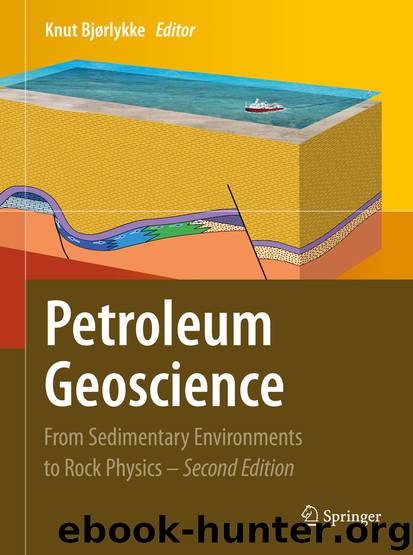Petroleum Geoscience by Knut Bjørlykke

Author:Knut Bjørlykke
Language: eng
Format: epub
Publisher: Springer Berlin Heidelberg, Berlin, Heidelberg
11.6 Summary
In subsiding sedimentary basins, mechanical compaction caused by the increase of effective vertical stresses is the dominating compaction process and has the greatest influence on the sediment’s porosity and hydro-mechanical properties down to depths of 2–2.5 km. At greater depths where temperatures are higher (>70°C), it is mainly the chemical compaction that contributes to the volume change and to the hydro-mechanical properties due to the effects of dissolution, precipitation and cementation. Carbonate rocks, though, may undergo chemical compaction at shallower depths.
The magnitude and distribution of stresses in sedimentary basins are important in relation to petroleum exploration, production and reservoir management. Knowledge of in situ stress is also important in connection with drilling, particularly during deviation and horizontal drilling. The magnitude and orientation of stresses affect the propagation and interpretation of seismic signals, particularly the S-waves, through sedimentary rocks.
The total vertical stress (σ v) of a rock sequence is carried partly by transmission of stress in the solid grain framework (effective stress σ ′ v) and partly by the pressure in the fluid phase (porewater or petroleum).
Determination of effective stresses depends on reliable estimates of the fluid pore pressure which often is in excess of hydrostatic (overpressure). There exist semi-empirical relationships for the ratio between horizontal and vertical effective stresses, but reliable estimates of horizontal stresses depend on field measurements like hydraulic fracturing tests. It is common practice in the petroleum industry to use a simplified procedure (leak-off tests) to determine the magnitude and orientation of the minimum horizontal stress.
The virgin (in situ) distribution of stresses in sedimentary basins is the result of both mechanical and chemical compaction, usually over geological time. Changes in stresses during petroleum production from a reservoir are much more short term and are mainly mechanical. In a carbonate reservoir the chemical processes may be so fast that also chemical compaction may become significant at that time scale.
The effective stresses in sand may cause grain-to-grain contact stresses which are so large that compression (compaction) may occur due to crushing and fracturing of grains. This is more pronounced in coarse-grained rather than fine-grained sands and may account for a significant component of the porosity reduction. After the grain crushing and permanent collapse deformations have occurred, the grain size is reduced and the reservoir regains stiffness. With increasing depth such grain crushing is less likely due to increased cementation of the grain structure caused by chemical processes. In most sandstone reservoirs quartz cementation starting at 2–2.5 km (70–80°C) will stabilise the grain framework and prevent further mechanical compaction. Sandstone reservoirs with a critical content of quartz cement (>2–3%) will therefore experience very little compaction even if the effective stress is increased during production. Similar compaction by grain breakage may also occur for high effective stresses in a reservoir where the framework of the sedimentary rock is very porous with little cement (e.g. the chalk in the Ekofisk reservoir, North Sea). Here this led to very large reservoir compaction and subsequent seafloor subsidence (c. 10 m).
Smectitic clays are characterised by very high ratios when compared with other clays (Fig.
Download
This site does not store any files on its server. We only index and link to content provided by other sites. Please contact the content providers to delete copyright contents if any and email us, we'll remove relevant links or contents immediately.
| Geomorphology | Historical |
| Limnology | Physical |
| Plate Tectonics | Sedimentary |
| Specific Locations | Structural |
| Volcanology |
Man-made Catastrophes and Risk Information Concealment by Dmitry Chernov & Didier Sornette(4737)
The Revenge of Geography: What the Map Tells Us About Coming Conflicts and the Battle Against Fate by Kaplan Robert D(3597)
Zero Waste Home by Bea Johnson(3292)
COSMOS by Carl Sagan(2950)
In a Sunburned Country by Bill Bryson(2948)
Good by S. Walden(2915)
The Fate of Rome: Climate, Disease, and the End of an Empire (The Princeton History of the Ancient World) by Kyle Harper(2436)
Camino Island by John Grisham(2384)
A Wilder Time by William E. Glassley(2364)
Organic Mushroom Farming and Mycoremediation by Tradd Cotter(2307)
Human Dynamics Research in Smart and Connected Communities by Shih-Lung Shaw & Daniel Sui(2178)
The Ogre by Doug Scott(2114)
Energy Myths and Realities by Vaclav Smil(2061)
The Traveler's Gift by Andy Andrews(2012)
Inside the Middle East by Avi Melamed(1940)
Birds of New Guinea by Pratt Thane K.; Beehler Bruce M.; Anderton John C(1906)
Ultimate Navigation Manual by Lyle Brotherton(1768)
A History of Warfare by John Keegan(1715)
And the Band Played On by Randy Shilts(1615)
